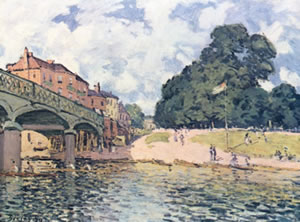Just before Christmas, Molesey Matters reader, Jacqueline Martin, contacted me regarding the artist Alfred Sisley. A few years ago, Jacqueline conducted some research for the Alfred Sisley Museum in Moret-sur-Loing outside Paris where the artist spent most of his life. As an artist who both came to Molesey and painted here I felt compelled to find out more.
Sisley was born in Paris to affluent British parents. His father, William Sisley, was in the silk business, and his mother Felicia Sell was a cultivated music connoisseur.
In 1857 at the age of 18, Sisley was sent to London to study for a career in business, but he abandoned it after four years and returned to Paris in 1861. From 1862, he studied at the Paris where he became acquainted with Monet and Renoir Together they would paint landscapes “en plein air” rather than in the studio, so as to realistically capture the transient effects of sunlight. This approach, innovative at the time, resulted in paintings more colourful and more broadly painted than the public was accustomed to seeing. Consequently, Sisley and his friends initially had few opportunities to exhibit or sell their work. Their works were usually rejected by the jury of the most important exhibition in France, the annual Salon.
In 1870 the Franco Prussian war began, and as a result Sisley’s father’s business failed and the painter’s sole means of support became the sale of his works. For the remainder of his life he would live in poverty, as his paintings did not rise significantly in monetary value until after his death. Occasionally, however, Sisley would be backed by patrons; and this allowed him, among other things, to make a few brief trips to Britain.
The first of these occurred in 1874 after the first independent Impressionist exhibition. The result of a few months spent near London was a series of nearly twenty paintings of the Upper Thames near Molesey which was later described by an eminent art historian as “a perfect moment of Impressionism.”
While there, he painted a series of canvases at Hampton Court, including “Molesey Weir, Hampton Court” (1874; Edinburgh), which has been deemed remarkably fresh and spontaneous. “Molesey Weir” appears relaxed and informal, with its portrayal of naked bathers having been executed with great economy of means. In 1897 Sisley and his partner visited Britain again, and were finally married in Cardiff Register Office on 5 August. They stayed at Penarth where Sisley painted at least six oils of the sea and the cliffs.
In mid-August, they moved to the Osborne Hotel on the Gower Peninsula, where he produced at least eleven oil paintings in and around Langland Bay They returned to France in October. The painter died on 29 January 1899 in Moret-sur-Loing at the age of 59, a few months after the death of his wife.

